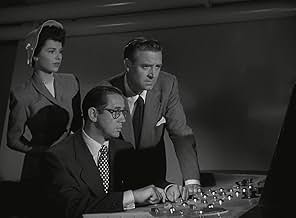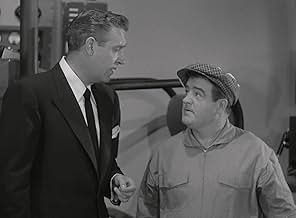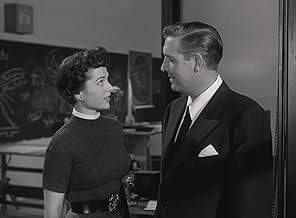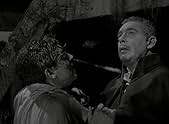Robert Paige(1910-1987)
- Actor
- Producer
- Additional Crew
A "B" Hollywood leading man who had the requisite tall, dark and
handsome features (plus an excellent singing voice) that Hollywood
often relied upon, Robert Paige was an extremely capable player worthy
of stronger dramatics but was too often trapped in staid and standard
leading man roles that prevented him from showcasing properly and
moving squarely into the "A" romantic ranks. Born John Arthur Paige on
December 21, 1910 in Indiana to English parents, Robert attended West
Point but eventually left the Academy and moved to the Los Angeles area
to focus on an entertainment career. Initially an usher for the Fox
West Coast Theatres, he started using the moniker David Carlyle while
singing on a Long Beach radio station and moved into announcing work at
radio station KMTR in Hollywood.
He entered short films in 1931 and progressed to feature status within a few years. A studio scout had the hopeful player screen-tested at Columbia, and he was put under contract. In the course of his career he was also a studio player for Warner Bros., Paramount and, more notably, Universal. His first prime second-lead role occurred crooning to Marion Davies in Cain and Mabel (1936). He went on to give a solid performance (still as David Carlyle) in Smart Blonde (1936), which introduced the "Torchy Blane" series, and finally top-lined his own romantic comedy Meet the Boy Friend (1937) opposite Carol Hughes.
In 1938 he returned to his given last name and billed himself as Robert Paige. There he fronted such standard programmers as Highway Patrol (1938), The Main Event (1938) and the serial cliffhanger Flying G-Men (1939). Over at Paramount things went about the same, continuing consistently but without a lot of fanfare, in such films as Emergency Squad (1940) Women Without Names (1940), Golden Gloves (1940) and The Monster and the Girl (1941). He earned his first singing lead with the mini-musical Dancing on a Dime (1940) in which he and co-star Grace McDonald sang the title song. The musical introduced the songs of Burton Lane and Frank Loesser, including "Mañana" (which Peggy Lee later made a signature hit) and the certified hit "I Hear Music."
Paige had his big chance at stardom at Universal in Can't Help Singing (1944) in which he sang "Californ-i-ay" in a duet with the studio's reigning warbler Deanna Durbin. The Gable-esque, often mustachioed baritone co-starred in other Universal musicals where he had plenty of opportunities to display his rich voice such as Hellzapoppin' (1941), Pardon My Sarong (1942), What's Cookin' (1942) and How's About It? (1943) but too often his listless romantic roles were overshadowed by the zany antics of the comic headliners (Abbott & Costello, The Ritz Brothers), the swinging harmonies and steps of The Andrews Sisters, guest musical artists, or the sheer magnetism of his lady co-star such as Durbin and Frances Langford. He fared better in rugged adventures, sprightly comedies, crime yarns and horror opuses, including Son of Dracula (1943) with Lon Chaney Jr. and Fired Wife (1943) with frequent co-star Louise Allbritton.
From 1946 on Paige freelanced. While on tour to promote the movie The Red Stallion (1947), Paige met oil millionaire Glenn McCarthy, who financed the picture The Green Promise (1949) in which Paige produced and starred. By the early 50s, he abandoned films for the most part and sought out TV roles. His well-modulated voice was ideal for hosting/emcee duties and went on to include Bride and Groom (1951) and The Big Payoff (1951) with former "Miss America" Bess Myerson, among his jobs. His last two roles on films were minor bits in The Marriage-Go-Round (1961) and Bye Bye Birdie (1963). From 1966 to 1970 he went full circle, returning to his radio roots as an ABC newscaster in Los Angeles. From there he moved into public relations. Married three times in all, the durable leading man died in 1987.
He entered short films in 1931 and progressed to feature status within a few years. A studio scout had the hopeful player screen-tested at Columbia, and he was put under contract. In the course of his career he was also a studio player for Warner Bros., Paramount and, more notably, Universal. His first prime second-lead role occurred crooning to Marion Davies in Cain and Mabel (1936). He went on to give a solid performance (still as David Carlyle) in Smart Blonde (1936), which introduced the "Torchy Blane" series, and finally top-lined his own romantic comedy Meet the Boy Friend (1937) opposite Carol Hughes.
In 1938 he returned to his given last name and billed himself as Robert Paige. There he fronted such standard programmers as Highway Patrol (1938), The Main Event (1938) and the serial cliffhanger Flying G-Men (1939). Over at Paramount things went about the same, continuing consistently but without a lot of fanfare, in such films as Emergency Squad (1940) Women Without Names (1940), Golden Gloves (1940) and The Monster and the Girl (1941). He earned his first singing lead with the mini-musical Dancing on a Dime (1940) in which he and co-star Grace McDonald sang the title song. The musical introduced the songs of Burton Lane and Frank Loesser, including "Mañana" (which Peggy Lee later made a signature hit) and the certified hit "I Hear Music."
Paige had his big chance at stardom at Universal in Can't Help Singing (1944) in which he sang "Californ-i-ay" in a duet with the studio's reigning warbler Deanna Durbin. The Gable-esque, often mustachioed baritone co-starred in other Universal musicals where he had plenty of opportunities to display his rich voice such as Hellzapoppin' (1941), Pardon My Sarong (1942), What's Cookin' (1942) and How's About It? (1943) but too often his listless romantic roles were overshadowed by the zany antics of the comic headliners (Abbott & Costello, The Ritz Brothers), the swinging harmonies and steps of The Andrews Sisters, guest musical artists, or the sheer magnetism of his lady co-star such as Durbin and Frances Langford. He fared better in rugged adventures, sprightly comedies, crime yarns and horror opuses, including Son of Dracula (1943) with Lon Chaney Jr. and Fired Wife (1943) with frequent co-star Louise Allbritton.
From 1946 on Paige freelanced. While on tour to promote the movie The Red Stallion (1947), Paige met oil millionaire Glenn McCarthy, who financed the picture The Green Promise (1949) in which Paige produced and starred. By the early 50s, he abandoned films for the most part and sought out TV roles. His well-modulated voice was ideal for hosting/emcee duties and went on to include Bride and Groom (1951) and The Big Payoff (1951) with former "Miss America" Bess Myerson, among his jobs. His last two roles on films were minor bits in The Marriage-Go-Round (1961) and Bye Bye Birdie (1963). From 1966 to 1970 he went full circle, returning to his radio roots as an ABC newscaster in Los Angeles. From there he moved into public relations. Married three times in all, the durable leading man died in 1987.





























